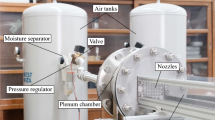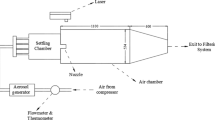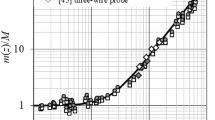Abstract
Near-field mixing characteristics of horizontally issuing jets, alternatively positively and negatively buoyant, are explored. The cross-sectional mass fraction of a buoyant horizontal jet consisting of helium flowing into ambient air is measured using a non-intrusive technique, filtered Rayleigh scattering, for Reynolds numbers ranging from 50 to 1,200, Froude numbers ranging as low as 0.71, and Schmidt numbers on the order of unity for all tests. Several corresponding experiments were carried out using carbon dioxide in place of helium in order to determine whether the direction of the buoyancy changes the characteristic shape of the jet cross-section. Consistent with the literature, mixing rates were consistently higher on the side of the jet where instability, due to density stratification, was present. At jet Froude numbers ranging between 1.5 and approximately 3, the jet cross-section takes a shape consistent with a single plume of fluid being ejected from the core in a vertical direction—upward for a jet with positive buoyancy and downward for a jet with negative buoyancy. Remarkably, for Froude numbers less than unity, the distortion of the jet is quite different in that two separate plumes emanate from each side of the jet while ejection from the center is suppressed. Both the positively and negatively buoyant jet cross-sections exhibited this trait, suggesting that the mechanism that determines the cross-sectional shape of the jet core is only mildly influenced by centripetal effects brought about by streamline curvature. The location of the jet centroid at varied streamwise locations was computed from the mass fraction data, yielding jet trajectory.

















Similar content being viewed by others
Abbreviations
- A :
-
Cross-sectional area of the jet, m2
- D :
-
Tube diameter, m
- g :
-
Gravitational constant, m/s2
- LM :
-
Transition length scale, m
- Q :
-
Volumetric flow rate, m3/s
- μ:
-
Viscosity, kg-m/s
- ρa :
-
Density of the ambient air, kg/m3
- ρj :
-
Density of the jet, kg/m3
- Fr:
-
Froude number
- Re:
-
Reynolds number
References
Arakeri JH, Das D, Srinivasan J (2000) Bifurcation in a buoyant horizontal laminar jet. J Fluid Mech 412:61–73
Batchelor GK, Canuto VM, Chasnov JR (1992) Homogeneous buoyancy-generated turbulence. J Fluid Mech 225:349–378
Beck WH, Stockman E, Zaidi SH, Miles RB (2006) Rayleigh scattering measurements for obtaining spatially resolved absolute gas densities in large scale facilities. AIAA Paper 2006-0835
Boguszko M, Elliott GS (2005) Property measurement utilizing atomic/molecular filter-based diagnostics. Prog Aerosp Sci 41:93–142
Crafton JW, Carter CD, Elliott GS (2001) Three-component phase-averaged velocity measurements of an optically perturbed supersonic jet using multi-component planar Doppler velocimetry. Meas Sci Technol 12:409–419
Dimotakis PE (2005) Turbulent mixing. Annu Rev Fluid Mech 37:329–356
Hasselbrink EF, Mungal MG (2001) Transverse jets and flames. Part 2. Velocity and OH field imaging. J Fluid Mech 443:27–68
Jirka G (2004) Integral model for turbulent buoyant jets in unbounded stratified flows. Part I: single round jet. Environ Fluid Mech 4:1–56
Kikkert GA, Davidson MJ, Nokes RI (2007) Inclined negatively buoyant discharges. J Hydr Eng 133:545–554
List EJ (1982) Turbulent jets and plumes. Annu Rev Fluid Mech 14:189–212
Livescu D, Ristorcelli JR (2008) Variable-density mixing in buoyancy-driven turbulence. J Fluid Mech 605:145–180
Miles RB, Lempert WR, Forkey JN (2001) Laser Rayleigh scattering. Meas Sci Technol 12:33–51
Monkewitz PA, Pfizenmaier E (1991) Mixing by side jets in strongly forced and self-excited round jets. Phys Fluids A 3:1356–1361
Pan X, Schneider MN, Miles RB (2005) Power spectrum of coherent Rayleigh-Brillouin scattering in carbon dioxide. Physical Rev A 71:045801
Papantoniou D, List EJ (1989) Large-scale structure in the far-field of buoyant jets. J Fluid Mech 209:151–190
Querzoli G, Cenedese A (2005) On the structure of a laminar buoyant jet released horizontally. J Hydraul Res 43:71–85
Richards CD, Pitts WM (1993) Global density effects on the self-preservation behaviour of turbulent free jets. J Fluid Mech 254:417–435
Satyanarayana S, Jaluria A (1982) A study of laminar buoyant jets discharged at an inclination to the vertical buoyancy force. Int J Heat Mass Transf 25:1569–1576
Sneep M, Ubacks W (2005) Direct measurement of the Rayleigh scattering cross section in various gases. J Quant Spectrosc Radiat Transf 92:293–310
Su LK, Helmer DB, Brownell CJ (2010) Quantitative planar imaging of turbulent buoyant jet mixing. J Fluid Mech 643:59–95
Subbarao ER, Cantwell BJ (1992) Investigation of a co-flowing buoyant jet: experiments on the effect of Reynolds number and Richardson number. J Fluid Mech 245:69–90
Xiao J, Travis JR, Breitung W (2009) Non-Boussinesq integral model for horizontal turbulent buoyant round jets. Science and Technology of Nuclear Installations, vol 2009, Article ID 862934,7 p
Acknowledgments
This work was supported through a grant from the Air Force Office of Scientific Research (contract monitor: Dr. Julian Tishkoff, Program Manager for Combustion and Diagnostics). The authors are also grateful for the support of the Propulsion Directorate of the Air Force Research Laboratory, specifically Dr. Joseph Zelina and Dr. Cam Carter. We would also like to thank Dr. Jim Crafton of Innovative Scientific Solutions Incorporated for helpful suggestions in setting up the experiment. Views expressed in this article are those of the authors and do not reflect the official policy or position of the United States Air Force, Department of Defense, or the U.S. Government.
Author information
Authors and Affiliations
Corresponding author
Rights and permissions
About this article
Cite this article
Reeder, M.F., Huffman, R.E., Branam, R.D. et al. Near-field development of gas-phase horizontal laminar jets with positive and negative buoyancy measured with filtered Rayleigh scattering. Exp Fluids 50, 1455–1472 (2011). https://doi.org/10.1007/s00348-010-0999-5
Received:
Revised:
Accepted:
Published:
Issue Date:
DOI: https://doi.org/10.1007/s00348-010-0999-5




